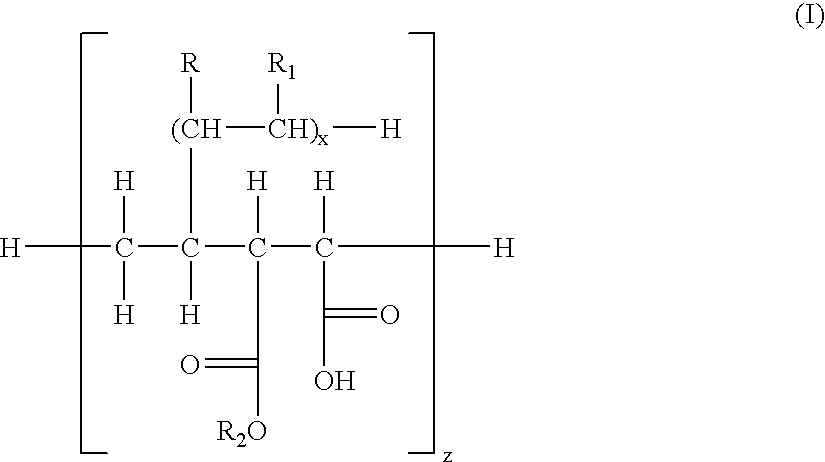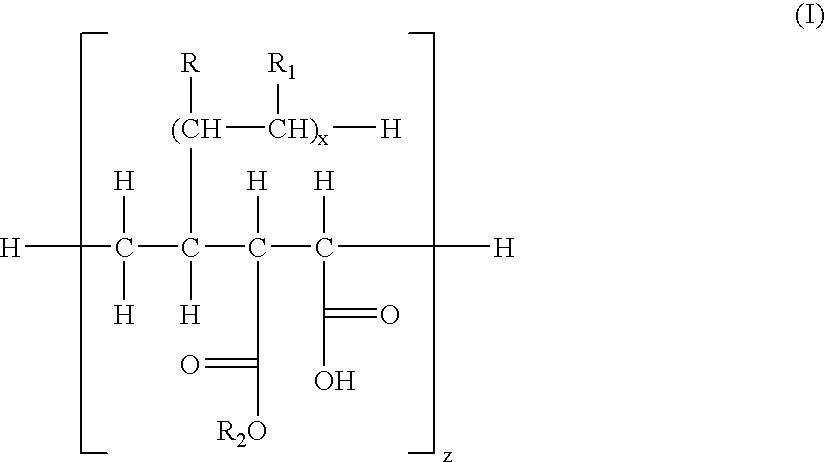Direct thermographic materials with improved protective layers
- Summary
- Abstract
- Description
- Claims
- Application Information
AI Technical Summary
Problems solved by technology
Method used
Image
Examples
example 1
[0183] This example shows the superiority of the protective layer according to the present invention in terms of preventing sticking and providing smooth transfer of the imaging material across the thermal printhead. A defect or deficiency in the performance of that layer causes intermittent rather than continuous transport across the thermal printhead. The silver image thus formed does not appear as a uniform area, but rather as a series of alternating light and dark bands.
[0184] Smooth transfer across a wide range of printing conditions is another desirable performance characteristic for a protective layer. Variable print forces along either the length or the width of a print could cause image defects.
[0185] Preparation of Backside Conductive Antistatic Coatings:
[0186] Backside Undercoat Formulation:
[0187] A backside undercoat non-conductive layer formulation was prepared by mixing the following materials:
MEK94.5partsCAB 381-204.4partsVITEL ® PE-2700B LMW1.1parts
[0188] Backs...
example 2
[0214] The following example shows the improvement in retaining the force characteristics (that is, the transport properties of the protective layer) when thermographic samples were subjected to accelerated aging.
[0215] The following inventive protective layer solutions were prepared:
[0216] Sample 2-1 was prepared in an identical manner to Sample 1-1 above.
[0217] Sample 2-2 was prepared in an identical manner to Sample 1-1 above except that poly α-olefin X-6112 (Baker Petrolite) was used in place of VYBAR® 103.
[0218] Comparative Sample A was prepared in an identical manner to Sample 1-8.
[0219] The initial Dmax force was measured, followed by storage of the samples in an environmental chamber for seven days at 120° F. / 50% RH to simulate the effects of long-term aging. The Dmax force was again measured.
[0220] The results, shown below in TABLE IV, demonstrate that inventive Samples 2-1 and 2-2 had a lower change in Dmax force (Δ) when compared to Comparative Sample A. This indica...
example 3
[0221] Preparation of Backside Conductive Antistatic Coatings:
[0222] This example compares the use of the polymeric materials of this invention with silicone oil to provide protective topcoat layers with similar force values (similar friction) across different density patches.
[0223] Backside Undercoat Formulation:
[0224] A backside undercoat conductive layer formulation was prepared by mixing the following materials:
CELNAX ® CX-Z401M50.0parts(containing 40% active solids)MEK375partsVITEL ® PE-2700B LMW4.39partsCAB 381-2017.5parts
[0225] Backside Topcoat Formulation:
[0226] A backside topcoat formulation was prepared by mixing the following materials:
MEK87.2partsCAB 381-2011.0partsSYLOID ® 74X60000.14parts
[0227] The buried backside conductive layer formulation and backside topcoat formulations were coated onto one side of a 7 mil (178 μM) blue tinted poly(ethylene terephthalate) support. A precision multilayer coater equipped with an in-line dryer was used. The coating weight of...
PUM
| Property | Measurement | Unit |
|---|---|---|
| Temperature | aaaaa | aaaaa |
| Temperature | aaaaa | aaaaa |
| Temperature | aaaaa | aaaaa |
Abstract
Description
Claims
Application Information
 Login to View More
Login to View More - R&D
- Intellectual Property
- Life Sciences
- Materials
- Tech Scout
- Unparalleled Data Quality
- Higher Quality Content
- 60% Fewer Hallucinations
Browse by: Latest US Patents, China's latest patents, Technical Efficacy Thesaurus, Application Domain, Technology Topic, Popular Technical Reports.
© 2025 PatSnap. All rights reserved.Legal|Privacy policy|Modern Slavery Act Transparency Statement|Sitemap|About US| Contact US: help@patsnap.com



